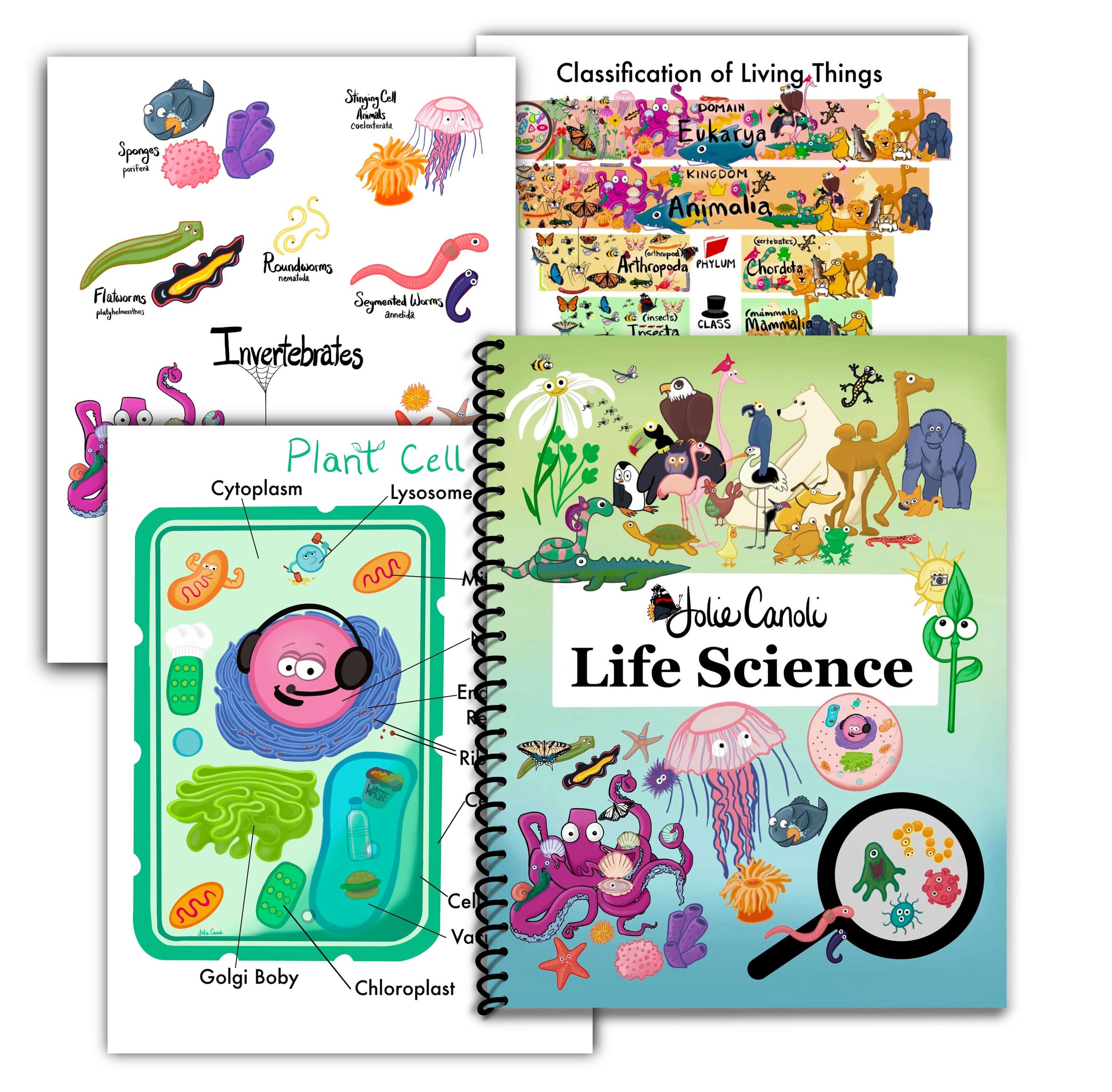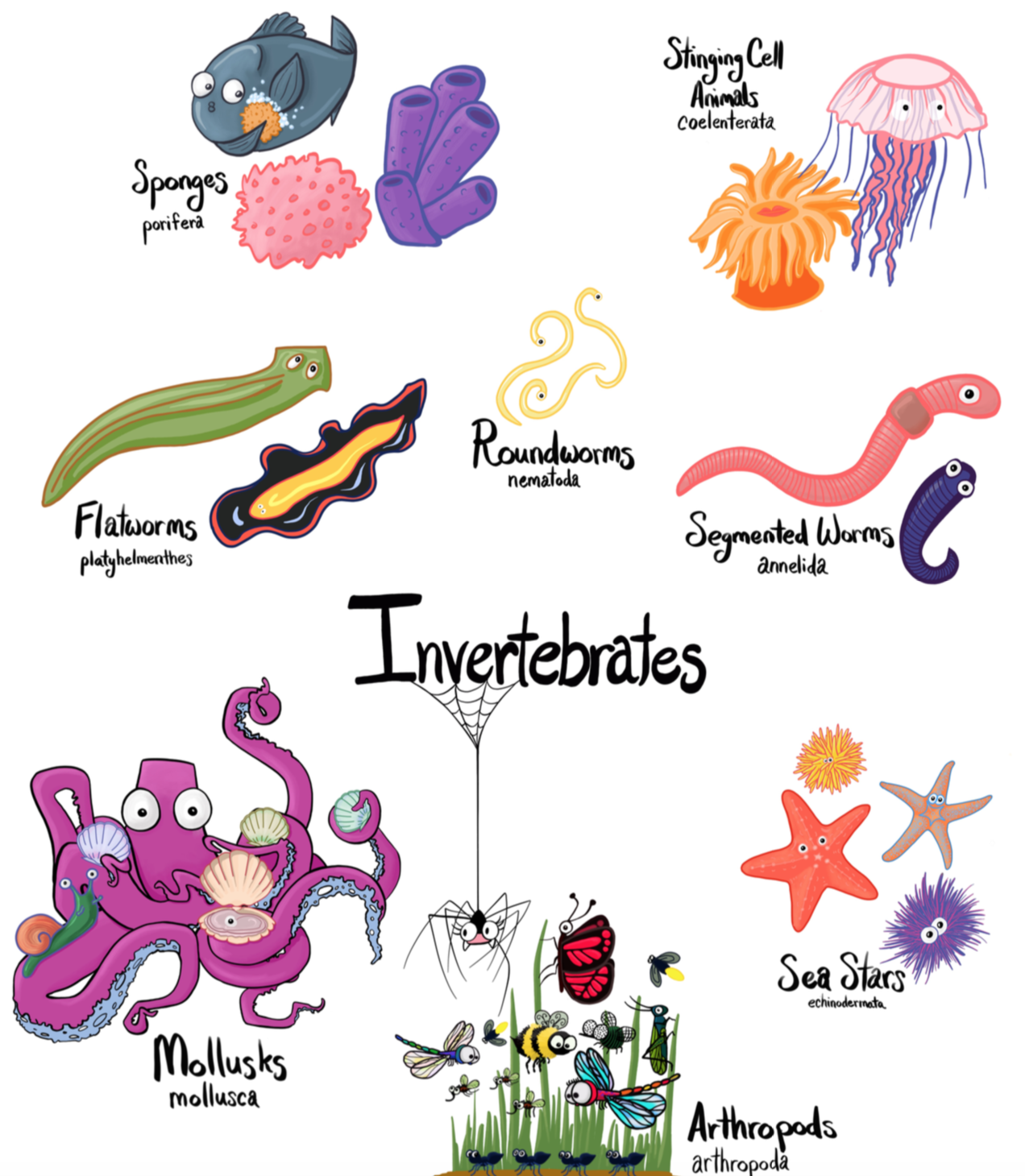Learn about physics, astronomy, and thermodynamics in these fun and simple experiments using easy to find household items.
Vertebrates- Animals with Backbones
See these animals giving one another a back rub? They are all vertebrates. Vertebrates are animals with backbones (vertebrae). The 5 classes of vertebrates are: Fish, Amphibians, Reptiles, Mammals, and Birds.
Fish (Gills, Fins, Scales, Cold Blooded)
Fish are the only group of vertebrates that live entirely in water. All of them have gills, which is special breathing tissue that allows fish to breathe oxygen underwater. Fish have fins which help them paddle and maneuver through water. They also have scales that protect their bodies like armor. You can actually determine the age of fish by counting the rings on their scales! Fish are cold blooded animals which means their blood becomes cooler or hotter depending on the temperature of the water. Fish will swim slowly below the ice during winter, or even sleep in icy waters. Some fish actually produce antifreeze molecules called glycoprotein that keep their bodies from freezing in really cold temperatures!
Amphibians (Slimy skin, Metamorphosis, Four Legs, Cold Blooded)
Amphibians like frogs, toads, and salamanders are born in water and develop the ability to live on land. This means almost all amphibians will go through metamorphosis. (Think of how tadpoles become frogs.) Most are born with gills and then develop lungs and four legs, though caecilians do not have legs. They have permeable, wet, slimy skin that absorbs water and oxygen, and usually have webbed feet. Amphibian eggs have no shell, but are covered in a jelly-like substance. Amphibians are also cold blooded, so they are quick and active when it is warm, but slow and sluggish when it is cold.
Reptiles (Scales, Eggs, Four Legs, Cold blooded)
Reptiles like turtles, snakes, crocodilians, and lizards are covered with scales, and usually have claws. Reptiles are cold blooded creatures and lay eggs. They are tetrapods, meaning they have four legs, or in the case of snakes, “descended” from creatures with four legs. Interestingly there are a number of snake fossils with legs, and some pythons have vestiges of legs.
Mammals (Hair, Milk, Live Birth, Warm blooded)
Mammals can be bears, bunnies, or even whales. Mammals give birth to live young. Mammals get their names from mammary glands that produce milk to feed their newborn babies. All mammals have hair or fur that helps them maintain their warm blooded bodies. All mammals have lungs and breathe air, so most mammals live on land, but some live in the sea. These marine animals include pinnipeds (seals, sea lions), cetaceans (whales, porpoises), sea otters, sirenians (manatees), and polar bears.
Birds (Feathers, Beak, Eggs)
Birds can be as tiny as a hummingbird or as large as an ostrich. All birds have feathers, though not all of them fly. Penguins have feathers, but they swim. Ostriches and emus have large feathers, but their sternum is not attached to their pectoral muscles, making them too weak to fly. All birds have a beak. Beaks come in many shapes and sizes, and are used for different purposes, including tearing meat, breaking seeds, sipping nectar, fishing, or finding and eating insects.
Enjoy the FREE printable vertebrate packet more fun illustrations, a poster, study guide, and short quiz!
For more fun consider studying:
Different types of feathers
Four types of fish scales (Placoid, Cosmoid, Ganoid, Cycloid)
Explore reptiles!
Go find some frogs at your local pond! Be sure to wash your hands…
Try making a list of the mammals that live in your neighborhood. Or try one of these cool ideas!
Visit the local pet shop and see if you can identify what creatures belong in which vertebrate class!
Biology Basics: Invertebrates
Invertebrates are definitely some of the weirdest, creepiest, slimiest and most interesting creatures on earth. Worms, bugs, octopus and jellyfish all fall into the category of inveterate animals. When looking at the classification of the animal kingdom, there are 9 major phylum, and 8 of these are invertebrates! These 8 phylum, or body-type classifications are sponges, stinging cell animals, three groups of worms (flat, round, segmented), mollusks, echinoderms (also known as sea stars), and arthropods.
One of the best parts about studying invertebrates is the ease of finding them in your own backyard. Many of the invertebrates are easy to find if you just dig in your garden, or even, heaven forbid, look in your basement! If your kids have the courage, they can handle the creepy creatures and study them first hand- literally!
I’ve attached a handy dandy printable with a poster, study guide, and a quiz. Hope you enjoy this invertebrate study tool!




